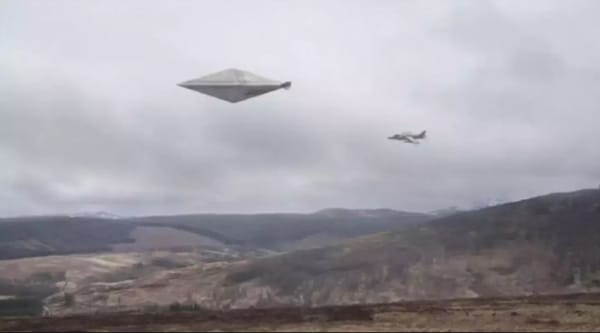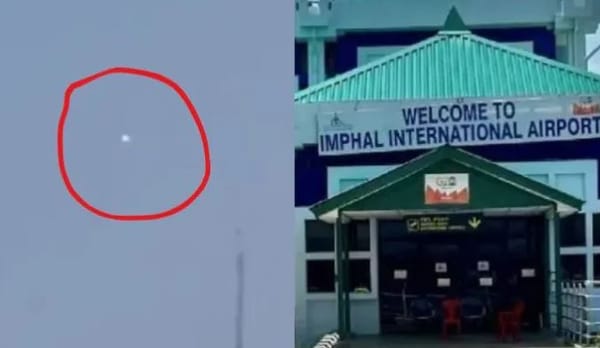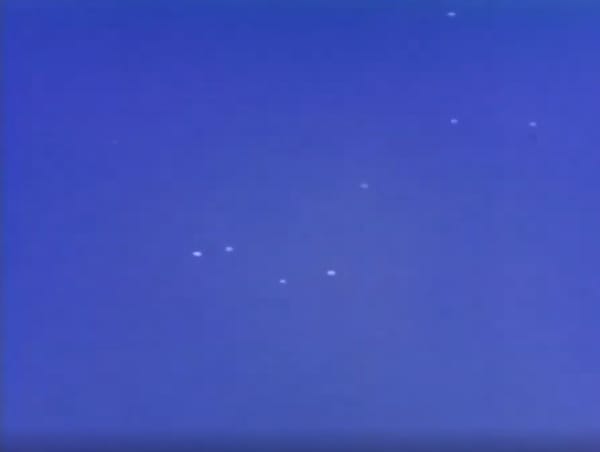The 1976 Tehran UFO Incident

In 1976, the skies over Tehran witnessed an extraordinary event that would capture the fascination of both the public and military experts alike. Iranian fighter jets engaged with an enigmatic unidentified flying object (UFO) in a high-stakes encounter marked by dazzling lights, electronic interference, and mysterious maneuvers. This incident was not an isolated occurrence; it was followed by further unexplained aerial phenomena involving Iran’s military, including dramatic encounters with advanced aircraft and tragic incidents resulting in loss of life. These sightings, occurring over decades, have led to widespread speculation and debate.
Iranian UFO encounters have sparked intrigue not only because of their detailed and credible military reports but also due to their seemingly sophisticated technology and eerie precision. The technology exhibited by these UFOs—ranging from the ability to disable electronic systems to achieving speeds of Mach 10—defies conventional understanding and has given rise to a variety of theories. Some suggest these objects might be advanced human technology, potentially from rival nations, while others propose the possibility of extraterrestrial origins.
As the mystery deepens, questions remain about the nature and purpose of these UFOs. Were they a form of secret advanced technology or a signal of otherworldly interest? In this article, we delve into the Tehran UFO event and subsequent encounters to explore the theories, eyewitness accounts, and the broader implications of these intriguing phenomena. Join us as we unravel the layers of this ongoing enigma and consider the potential explanations behind Iran's most puzzling aerial mysteries.
The Incident
The Tehran UFO incident of September 19, 1976, is one of the most well-documented encounters between military aircraft and unidentified flying objects. This event took place in the early hours of the morning, and its details have been pieced together through official reports, witness accounts, and declassified documents.
Initial Reports
Around midnight, residents of Tehran began calling the local airport, reporting sightings of bright, unusual lights in the sky. The lights appeared to hover and then dart across the sky in a manner inconsistent with known aircraft or natural phenomena. General Yousefi, the commander of Tehran's airfield, confirmed these reports after stepping outside and observing the lights himself. Their erratic behavior prompted immediate concern and necessitated a military response.
First Military Response
At approximately 1:30 A.M., General Yousefi ordered Lt. Yaddi Nazeri and his backseat weapons officer to investigate the lights in an F-4 Phantom fighter jet. As they approached the UFO, they experienced a significant malfunction: all navigational and communication systems failed. The aircraft's instruments went haywire, and Lt. Nazeri had to rely solely on visual cues and instinct to fly. Recognizing the situation as too hazardous to continue, Nazeri decided to retreat. Upon moving away from the UFO, the aircraft's systems returned to normal functioning, indicating possible interference from the unidentified object.
Second Military Response
A second F-4 Phantom was launched at 1:40 A.M., piloted by Lt. Parviz Jafari. This aircraft successfully acquired a radar lock on the UFO, confirming its physical presence in the airspace. Lt. Jafari observed the UFO as a solid mass that reflected radar signals, eliminating the possibility that it was an optical illusion or purely energy-based phenomenon. The UFO was emitting strobe lights in a sequence of blue, green, red, and orange, which were so rapid that they appeared almost solid.
As Lt. Jafari approached the UFO, it suddenly halted its forward motion and remained stationary in midair, defying conventional aerodynamic principles. This abrupt stop led Jafari to maneuver his aircraft around the UFO to avoid a potential collision. After a brief respite, he re-engaged with the object.
Critical Encounter
During the second engagement, the UFO released a bright, torpedo-like object towards Lt. Jafari's aircraft. The object appeared to be a missile or projectile of some kind. Jafari attempted to lock onto the incoming projectile with his AIM-9 Sidewinder infrared-guided missiles, but the weapons communication systems failed. Faced with the imminent threat, Jafari performed evasive maneuvers, including a barrel roll, to avoid the object. He reported that the projectile reversed course and rejoined the main UFO.
The UFO then released another bright object that descended towards the ground, leaving a visible trail of light. This object illuminated an area of approximately three kilometers before the UFO accelerated away, achieving speeds estimated at Mach 10—ten times the speed of sound. The object’s rapid departure from the atmosphere was observed by Jafari as a bright streak of light.
Aftermath and Further Investigation
Upon landing, Lt. Jafari’s aircraft encountered additional communication and navigational problems. These issues were also reported by a commercial airliner in the vicinity, though the airliner did not visually confirm the UFO. Ground troops sent to the area where the object had descended reported equipment malfunctions and found no physical evidence of the object.
Subsequent Reports
The Tehran incident remained the most significant UFO encounter reported by the Iranian military until similar events occurred in the early 2000s. These later incidents also involved advanced aerial phenomena and exhibited characteristics similar to those reported in 1976, including electromagnetic interference and extreme speeds.
Overall, the 1976 Tehran UFO incident stands as a critical case in the study of UFO encounters, marked by credible military witnesses, significant technological disruptions, and an unresolved mystery regarding the nature and origin of the observed phenomena.
Possible Explanations
The Tehran UFO incident of 1976 has been the subject of extensive analysis and speculation. Given the detailed reports from military personnel and the documented technological anomalies, various explanations have been proposed. These range from advanced but terrestrial technology to potential extraterrestrial origins. Below are some of the prominent theories that have been discussed in relation to the incident.
1. Advanced Military Technology
One of the most discussed explanations is that the UFOs observed were advanced military aircraft, potentially of either Iranian or foreign origin. The technological capabilities attributed to the UFOs—such as rapid acceleration, high speeds, and electromagnetic interference—suggest advanced engineering. Some theories propose that the objects could have been classified aircraft from other countries, such as the United States or the Soviet Union, which might have been testing new technologies.
- Electromagnetic Interference: The reported electromagnetic interference experienced by the F-4 Phantom jets could be attributed to sophisticated electronic countermeasures used by advanced aircraft. Such countermeasures might have been designed to disable enemy systems temporarily during reconnaissance missions or tests.
- Stealth and Advanced Propulsion: The UFO’s ability to achieve speeds up to Mach 10 could be explained by advanced propulsion systems that are currently unknown to the public. This could include experimental propulsion technologies like scramjets or other high-speed systems that may be developed in secret.
2. Extraterrestrial Hypothesis
The extraterrestrial hypothesis posits that the objects observed were of non-human origin. Proponents of this theory argue that the UFOs exhibited capabilities far beyond any known terrestrial technology.
- Flight Characteristics: The ability of the UFOs to hover without visible means of support and achieve extreme speeds without apparent propulsion systems aligns with common descriptions of advanced extraterrestrial technology in UFO lore.
- Unexplained Phenomena: The reported strobing lights, rapid acceleration, and sudden disappearances from the atmosphere are consistent with descriptions of alien spacecraft in other UFO encounters.
3. Weather or Atmospheric Phenomena
Some researchers have suggested that the observed phenomena might have been related to rare weather or atmospheric conditions that created unusual visual effects. This theory examines whether atmospheric phenomena like ball lightning or meteorological optical illusions could account for the reported observations.
- Ball Lightning: This rare and poorly understood phenomenon can produce glowing orbs that might explain some aspects of the visual reports. However, ball lightning does not typically exhibit the flight characteristics or technological interference described in the incident.
- Atmospheric Refraction: Variations in atmospheric conditions can sometimes create optical illusions of objects moving erratically or appearing to hover. Yet, this explanation does not account for the technological disruptions experienced by the aircraft.
4. Technological Malfunction or Hoax
Another possibility is that the UFO reports were a result of technological malfunctions or deliberate hoaxes. This could involve:
- Radar and Communication Malfunctions: It’s conceivable that the reported failures of navigational and communications systems were due to malfunctions or technical issues unrelated to any actual UFO activity.
- Hoax or Misidentification: While less likely given the credibility of the witnesses, some have suggested that the incident could be a hoax or a case of misidentification of conventional aircraft or atmospheric phenomena.
5. Psychological and Perceptual Factors
The psychological impact of an unusual encounter might influence perceptions and reports. Stress, fatigue, and the high-stakes environment could lead to misinterpretations of the observed phenomena.
- Perceptual Errors: In high-stress situations, such as a military engagement with an unknown object, the human brain may misinterpret data or visual stimuli, leading to reports that reflect more the perception of the event rather than the actual event.
Each of these theories provides a lens through which to view the Tehran UFO incident, but none fully account for all the reported details and anomalies. The possibility of advanced military technology, extraterrestrial visitors, or atmospheric phenomena are all compelling in their own right, but without definitive evidence, the true nature of the objects observed in Tehran remains unresolved.
Conclusion
The Tehran UFO incident of 1976 stands as one of the most intriguing and thoroughly documented cases in the history of aerial phenomena. The detailed accounts from Iranian military personnel, combined with the technological anomalies reported, make this case particularly significant in the study of unidentified flying objects.
Despite extensive investigation and analysis, a definitive explanation remains elusive. The range of possible explanations—from advanced military technology and extraterrestrial origins to atmospheric phenomena and human error—reflects the complexity and mystery surrounding the event. Each theory presents compelling arguments, but none fully account for all aspects of the encounter.
The incident underscores the challenges inherent in analyzing UFO sightings, particularly when they involve high-stress military scenarios and advanced technological features. It highlights the need for continued research and open-minded inquiry into unexplained aerial phenomena.
As new technologies and methodologies emerge, future investigations may provide more clarity on these mysterious encounters. Until then, the Tehran UFO incident remains a captivating example of the unknown and a reminder of the limits of our current understanding of aerial phenomena. Whether these sightings are attributed to advanced secret technology, extraterrestrial visitors, or other phenomena, they continue to stimulate curiosity and debate within both the scientific community and the public.



